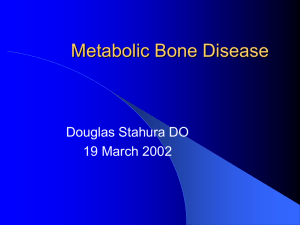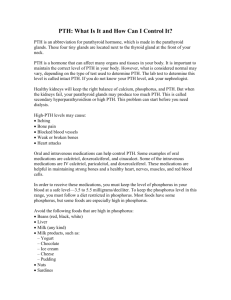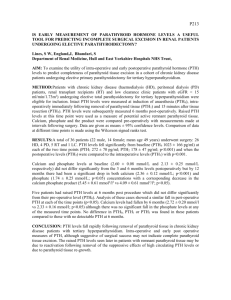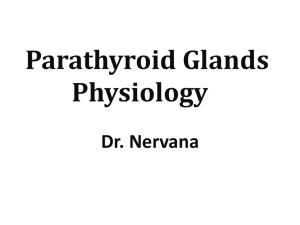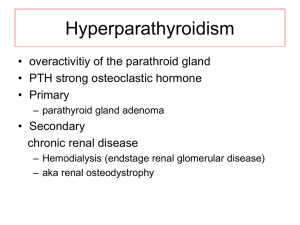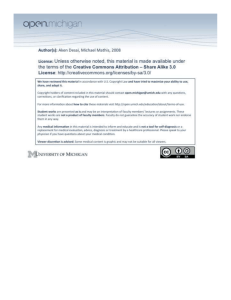Word
advertisement
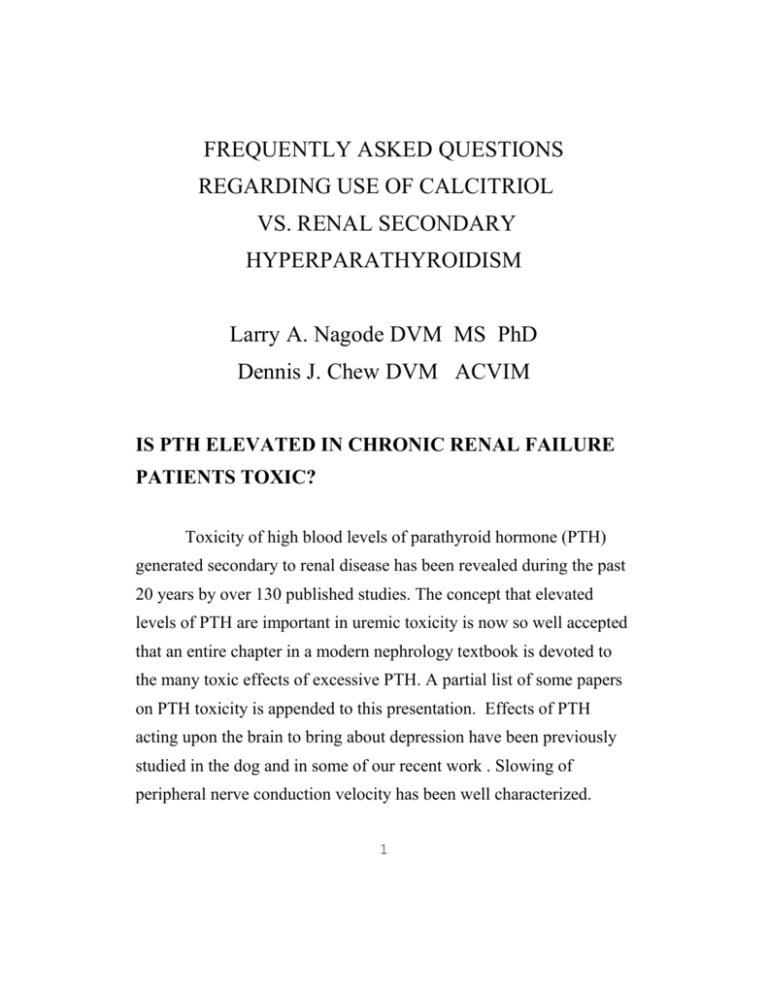
FREQUENTLY ASKED QUESTIONS REGARDING USE OF CALCITRIOL VS. RENAL SECONDARY HYPERPARATHYROIDISM Larry A. Nagode DVM MS PhD Dennis J. Chew DVM ACVIM IS PTH ELEVATED IN CHRONIC RENAL FAILURE PATIENTS TOXIC? Toxicity of high blood levels of parathyroid hormone (PTH) generated secondary to renal disease has been revealed during the past 20 years by over 130 published studies. The concept that elevated levels of PTH are important in uremic toxicity is now so well accepted that an entire chapter in a modern nephrology textbook is devoted to the many toxic effects of excessive PTH. A partial list of some papers on PTH toxicity is appended to this presentation. Effects of PTH acting upon the brain to bring about depression have been previously studied in the dog and in some of our recent work . Slowing of peripheral nerve conduction velocity has been well characterized. 1 High blood PTH helps cause uremic anemia in many ways including as one of the causes of erythropoietin (EPO) deficits due of course mostly to loss of renal sites of EPO formation. A variety of leukocyte malfunctions are caused by excessive PTH in uremia including failures of immunologic response. Propensity of uremic patients to infections is related to this effect. We have reviewed several other toxic effects of PTH many of which are relevant to small animal medicine : Veterinary Clinics of North America 26:1293-1330 (Nov. 1996) WHAT IS THE MECHANISM OF PTH TOXICITY? Excessive PTH in uremia causes damage by interacting with the PTH or PTHrp receptor in target cells to increase levels of intracellular ionic calcium. High cellular calcium is toxic by activating various enzymes which destroy cell membranes, proteins and nucleic acids. In all sites including skeletal and heart muscle of uremic individuals, accumulation of calcium disrupts mitochondrial production of ATP diminishing tissue energy. Uremic animals and man develop hyperparathyroidism without deficits in blood calcium which is commonly at normal levels. Elevated blood calcium during uremic hyperparathyroidism is not uncommon, being present in about 14% of uremic dogs with those that were over 12.5 mg/dl having the worst hyperpara-thyroidism. No elevation of blood calcium is needed for PTH to cause cell damage by 2 calcium influx as normal blood calcium is 10,000 times as high as the normal cytosolic level of calcium. Contrary to dogma from the distant past, renal secondary hyperparathyroidism requires treatment in patients that do not reveal its presence by abnormal blood calcium or clinical bone disease. DO TOXIC LEVELS OF PTH DEPRESS UREMIC PATIENTS APPETITES? A PTH-mediated interference with the response of pancreatic insulin-secreting islet cells to a dietary intake of glucose explains much of the known carbohydrate intolerance of uremic patients. Without adequate insulin to facilitate lowering of blood glucose in uremia, one mechanism of the inappetence common in uremia may relate to high blood glucose caused initially by excess PTH. In our experience one early change in uremic animals in which PTH was lowered by calcitriol treatment has been a return of appetite. It has also been established that independent of lowering serum PTH, calcitriol directly facilitates insulin secretion by the islet cells as an explanation for the appetite stimulation seen early on in the calcitriol treated uremic patient when it is used preventively before elevations of PTH have developed. 3 IS THE PTH - DAMAGED KIDNEY RELATIONSHIP CYCLIC? The relationship between the hyperplastic, hypersecreting parathyroid gland and the damaged kidney in the uremic patient is one of a vicious cycle. The damaged kidneys effect changes that lead to hypersecretion of PTH. Because renal tubular cells have high concentrations of the receptor for PTH, the kidney is affected early in PTH toxicity. Marked calcium influx into tubular cells causes their death. Later, calcium phosphate precipitates within tubular lumens contributing to the renal damage. With loss of more renal tissue, hyperparathyroidism worsens, and the cycle continues. Breaking this cycle should be a major therapeutic objective in treating renal disease. Our results of eliminating hyperparathyroidism with calcitriol treatment suggest that eradication of the PTH mediated calcium influx can slow progression of the renal disease. Thus, elimination of hyperparathyroidism should lengthen patients lifespans. Recent work in England in cats compared 21 uremic hyperparathyroid cats without treatment of the high PTH to 29 uremic cats that had PTH lowered to the normal range. The 21 hyperparathyroid cats survived a median of 264 days after first diagnosis of chronic renal insufficiency whereas the 29 that had PTH lowered to normal survived a median of 633 days. 4 Veterinary workers in the U.S. were not able to obtain toxic levels of PTH in an initial 1994 short study of 15/16 nephrectomized dog as highest PTH levels were a bit less than 2 times the upper limit of normal. No PTH toxicity was found but none should have been expected as toxicity of PTH is seen after levels reach 3 times the upper limit of normal. When these workers in 1997 obtained toxic levels of PTH in a 2 year study again of 15/16 nephrectomized dogs half of which were also parathyroidectomized (PTX), those with elevated PTH had a progressive sharp drop in the glomerular filtration rate (GFR) compared to the PTX uremic dogs in which GFR remained little changed. These workers interpreted the GFR changes as due to changes in mineral metabolism rather than being directly due to PTH toxicity as quite extensive Ca-Pi depositions were present terminally in the dogs. Unfortunately for this explanation the GFR deficits appeared before serum phosphorus began elevating. A terminal massive increase in serum Pi was responsible for renal mineral deposits present in both hyperparathyroid and PTX dogs. A PTH toxicity of calcium influx occurred much earlier in the renal cells to damage or kill them and thus lower GFR in the dogs which had not had their parathyroids removed after the 15/16 nephrectomy. WHY DOESN'T CIMETIDINE WORK TO LOWER PTH? 5 Early studies using certain (carboxy-terminal or mid-molecule specific) types of radioimmunoassay for serum PTH suggested that cimetidine commonly used in uremic animals would lower blood levels of PTH. Repetition of such studies with assays that measured intact biologically active PTH (instead of 90-95% inactive fragments as detected by carboxy-terminal assays) revealed that instead of lowering blood levels of active PTH hormone, cimetidine actually had the opposite effect to raise them. These apparently conflicting results were due to the limitations of the outdated inappropriate PTH assays used in the earlier studies. In studies of renal secondary hyperparathyroidism, only assays detecting biologically active intact PTH should be used. None of the H2 blockers that are useful versus uremic gastritis has any value in management of hyperparathyroidism. WHAT IS CALCITRIOL? Calcitriol is 1,25 dihydroxycholecalciferol. It is a natural secosteroid hormone formed in the healthy body as the biologically active form of vitamin D. The liver 25-hydroxylation is much less controlled than the highly regulated 1-alpha hydroxylation of 25-hydroxyvitamin D that takes place almost exclusively in proximal tubule cells of the 6 kidney. For practical purposes in dogs and cats 1,25 dihydroxyergocalciferol (derived from vitamin D2) is also fully active calcitriol. Synthetic dihydrotachysterol (DHT) has previously been considered possibly useful in uremia. The lowest dosage of DHT recommended for uremic dogs, however, is 4,000 times higher than the starting dose of 2.5 nanograms/kg body wt. we have found generally effective for calcitriol. Overdosage can be a problem with DHT due to its long (3 week) half life in the body. The hypercalcemic toxicity of DHT overdosage lasts from 17-30 days. By contrast, the half life of calcitriol in blood is 4-6 hours which facilitates the rapid correction of hypercalcemia within about 4-6 days should it occur. The intestinal programming of calcium absorption by calcitriol in blood occurs only on those cells newly leaving the crypts of Lieberkuhn prior to their full differentiation. Those cells migrate up the villi with lifespans of about a week in cats and dogs before exit at the villus tip. A lowered calcitriol level therefore very quickly results in a gut with diminished calcium absorptive capacity. Calcitriol is both the most potent (allowing lowest dosages) and most rapidly cleared form of vitamin D available. These two features contribute to its remarkably high margin of safety in veterinary practice. Calcitriol when compounded for veterinary use needs to have stabilizing agents included to protect its 3 alcoholic groups from oxidation by the polyunsaturated oils used to dilute the calcitriol. Veterinarians are encouraged to use one of the more experienced compounding pharmacies to ensure stable 7 appropriate dosages. HOW DO PTH AND CALCITRIOL WORK TOGETHER NORMALLY? Parathyroid hormone (PTH) and calcitriol comprise the team of polypeptide and steroid hormones responsible for maintaining adequate levels of blood calcium. When blood calcium falls, PTH secretion is stimulated. PTH increases synthesis of calcitriol. Calcitriol increases calcium absorption in the intestine. In bone, calcitriol causes formation of increased numbers of osteoclasts . The activation of bone resorption brought about by PTH is markedly facilitated by these increased numbers of osteoclasts. Together PTH and calcitriol allow calcium to more readily get from bone to blood . Calcitriol also induces renal transport mechanisms which are activated by PTH to bring about increased tubular reabsorption of calcium from the glomerular filtrate thus preventing calcium loss in urine. Calcitriol, like other steroid hormones whose synthesis is activated by a trophic polypeptide hormone, has feedback inhibitory effects blocking both secretion and synthesis of PTH in the parathyroid gland. Parathyroid hormone increases calcitriol in blood whereas calcitriol decreases PTH in blood. 8 HOW IS CALCITRIOL AFFECTED BY CHRONIC RENAL DISEASE? During chronic renal failure the number of functioning renal tubules becomes progressively decreased. Because the tubular cells making calcitriol are lost, its synthesis becomes limited. An even greater limitation on calcitriol formation is the powerful inhibition of the 1-hydroxylation of 25-hydroxyvitamin D by high levels of blood phosphorus. As serum phosphorus levels increase, following reduced glomerular filtration rates, concentrations are achieved which block synthesis of calcitriol. Although high levels of Pi inhibit calcitriol, lowering serum Pi below normal does not raise serum calcitriol levels above normal in the dog. HOW IS THE FORMATION OF CALCITRIOL REGULATED? AND HOW DOES THIS RELATE TO THE CONTROL OF PARATHYROID HORMONE LEVELS IN UREMIA? Deficiencies of phosphorus, calcium and calcitriol itself lead to increased calcitriol formation, whereas excess of any of these leads to decreased synthesis of calcitriol. The inhibition by phosphorus is particularly powerful and important in uremia with a 1 mg/dl increase 9 in serum phosphorus decreasing blood calcitriol by 8 pg/ml or about 1/4 of the total average amount (32 pg/ml) normally present. These deficits of calcitriol caused by elevating serum phosphorus are partially counterbalanced by activations of calcitriol formation by the coexisting increased levels of parathyroid hormone. The potent activation of calcitriol formation by PTH is due in part to its phosphaturic lowering of tubule cell phosphorus levels thus relieving the phosphorus inhibition. Although this mechanism may be partly responsible, more complex interactions are considered to mediate most of the PTH activation of calcitriol synthesis. The increase of cellular cyclic AMP caused by PTH results in the dephosphorylation of renoredoxin which returns the 1-alpha hydroxylase enzyme to active status. The cAMP also acts at the kidneys 1-alpha hydroxylase gene to increase its transcription so more mRNA and protein for this enzyme is stimulated by PTH. This same gene regulatory system is inhibited by calcitriol itself and by factors associated with increased serum phosphorus. Because of the complexity of the multiple interactions between calcitriol, phosphorus, ionized calcium and serum PTH, one must use a "calcitriol trade-off hypothesis" to allow understandings of the changes in all these parameters that follow perturbation of any one of them. A diagramatic representation of this “calcitriol trade-off “ mechanism at both early and late stages of CRF is available in several of our publications including the Current Veterinary Therapy article of 1992 (CVT 11), The Seminars in Veterinary Medicine and Surgery 10 review in 1992, and the Veterinary Clinics of North America review in 1996. Diagrams are useful in following the changes in hormones and modulators that take place and interested parties are encouraged to get access to them. They can be FAXed to interested parties at no cost. Investigators have for many years observed a decrease in serum PTH in uremic patients that have a lowering of the elevated serum phosphorus. To explain events due to lowered serum phosphorus one must follow the changes of renal production of calcitriol as they occur. These are simply the reverse of those shown in the calcitriol “trade off “ as shown in the “early stages” diagram referred to on the previous page. Early in uremia lowering serum phosphorus raises calcitriol and Ca++ levels which then lower the previously elevated PTH---but due to the loss of high PTH stimulating calcitriol synthesis, the calcitriol and Ca++ levels return back to their original state. This could lead workers measuring calcitriol and Ca++ only at the beginning and end of the process to erroneously conclude that calcitriol and Ca++ did not change and so had no involvement in the lowering of PTH by the lowering of serum phosphorus. This incorrect conclusion has indeed been made by some investigators in both human and veterinary nephrology. This led to a search for the "mystery mechanism" by which phosphorus changes were affecting PTH apparently independently of calcitriol and Ca++. Some proposed mechanisms have been published involving effects of phosphorus to delay the rate 11 of degradation of the mRNA molecule for PTH but another laboratory could not repeat the experiments. Other recent research related phosphorus increases mostly to promotion of growth and cell replication in the parathyroid gland without apparent direct effects of hormone or its mRNA’s synthesis. An unfortunate aspect of this view is that some veterinary workers have thought that this might mean that control of serum phosphorus may be the only factor really needed to regulate PTH in the uremic patient. Because in Great Britain, calcitriol cannot be readily compounded for veterinary use as it can in the U.S., the idea that phosphorus control alone might suffice for PTH regulation in uremic veterinary patients was attractive. That this is a bad idea was revealed by early studies from our group. We showed that early in uremia, phosphorus control alone can suffice to lower PTH for a time in some dogs, but that later in uremia, control of phosphorus alone failed to lower PTH into a nontoxic range and that addition of calcitriol to the therapy could eliminate the elevation of PTH not responsive to lowering of serum phosphorus. This corresponds to the events shown diagramatically in the calcitriol “trade off” mechanism in late renal failure mentioned as available in our publications or by FAX. Phosphorus control is necessary in the management of excess PTH in uremic dogs and cats, but it is not sufficient. For many reasons we consider it unwise to delay use of calcitriol until late in renal failure and suggest instead that it be instituted early in renal failure to, with phosphorus restriction, help 12 prevent development of hyperplastic parathyroid glands producing excess PTH. HOW OFTEN DOES RENAL FAILURE CAUSE SECONDARY HYPERPARATHYROIDISM? Hyperparathyroidism occurs in most dogs and cats with chronic renal failure. Its extent is proportional to the increases of serum creatinine, and is quite directly related to the extent of uremic hyperphosphatemia. Serum phosphorus (Pi) is elevated primarily because of failure of renal excretion but its level is also affected by dietary intake, use of intestinal phosphorus binders and to some degree by the extent of PTH-mediated bone resorption. A level of PTH over 3 times the upper limit of normal (mean + 2 st.dev.) is required to be in the toxic range with histologic bone changes and renal damage expected at those levels. These PTH levels are seen at serum creatinine levels between 2.5 and 3 mg/dl when serum phosphorus varied throughout the range seen in patients on entry to a veterinary clinic. With prior control of phosphorus to be below 6 mg/dl the PTH levels are not toxically elevated usually until creatinine values are over about 3.5 mg/dl. The point at which serum PTH elevates, however, is individually variable and PTH assay is advisable when uncertain. Cat PTH in uremia is more difficult to detect accurately with present day assays than is dog PTH. Different facets of PTH toxicity manifest 13 themselves at varying levels of PTH excess with carbohydrate maladaptations requiring more marked PTH elevations than do other toxic effects. HOW DOES RENAL FAILURE CAUSE HYPERPARATHYROIDISM? The current state of knowledge of calcitriol-PTH relationships allows better interpretation of the classical views that the genesis of hyperparathyroidism in chronic renal failure is due to (a) hypocalcemia, (b) increased skeletal resistance to PTH, and/or (c) increased parathyroid gland set point for calcium suppression of PTH secretion. The original hypocalcemia view depended on a "trade off" hypothesis by which the increased serum phosphorus in uremia complexed ionic calcium by mass action lowering levels of ionic calcium thus increasing secretion of serum PTH. The increased PTH secretion brought about a phosphaturia, lowering serum phosphorus back toward normal, but at the expense of (or in a "trade off" for) increased serum PTH. Recent examination of the concentrations of phosphorus needed to accomplish this effect by simple mass action, however (35/1, phosphorus/calcium), revealed that serum phosphorus levels were not high enough to operate in this way until renal disease was more advanced than it is when hyperparathyroidism begins. Phosphorus concentrations are increased enough, however, to 14 markedly inhibit calcitriol formation at moderate stages of renal failure. The considerations above have led to the conclusion that a deficit of calcitriol is the most important factor leading to uncontrolled excessive secretion of parathyroid hormone. IS CA++ OR CALCITRIOL MORE IMPORTANT VERSUS PTH SYNTHESIS? Is calcitriol or ionized calcium (Ca++) the dominant factor controlling synthesis of the messenger RNA molecule for PTH in the parathyroid cell? Because PTH has a short half life in blood of no more than 5 minutes and glandular stores last only about an hour, maintenance of high blood levels of PTH even in acutely uremic patients requires high levels of synthesis of PTH. This is obviously yet more true of glands of chronically uremic patients which are characteristically devoid of PTH storage granules. Blood calcium levels can be as high as 20 mg/dl without any inhibitory effect upon PTH synthesis if the cells contain no calcitriol so calcium alone cannot block PTH synthesis. The blocking of PTH synthesis has as the primary event the binding of the calcitriol-receptor (VDR) complex to the DNA at the VDRE (nucleotide sequence) where it inhibits transcription of mRNA for PTH. That inhibition of transcription cannot take place if blood Ca++ is much below normal, as the calcium binding transcription factor bound to the CaRE in the DNA works cooperatively with the VDR at the accessory factors to prevent release of 15 the RNA polymerase. It does not require Ca++ levels higher than normal but suppressed ionization of calcium by 0.1 mg/dl such as by a 3.5 mg/dl increase in serum phosphorus can result in failed control of PTH gene transcription. Dependence of PTH transcription upon normal levels of ionized calcium is logical in that it would not be biologically reasonable for calcitriol to shut PTH synthesis down if the patient were to be hypocalcemic. Stoppage of PTH synthesis cannot take place at all in the absence of calcitriol. This reveals that both calcitriol and at least normal levels of ionized calcium should be considered crucial controlling factors for transcription of the PTH gene. This set of relationships is best pictured with a diagram which is available both on page 1314 in the Veterinary Clinics of North America review of November 1996 and on page 114 in the 2cnd edition (2000) of the textbook “Fluid Therapy in Small Animal Practice” where Dr. Rosol, Dr. Chew, Dr. Schenck and I are coauthors of the chapter titled “Disorders of Calcium” (pp.108-162). It is, like the “trade-off” diagrams mentioned above available by FAX to interested parties who do not have access to either of the two publications mentioned. DOES CALCITRIOL PREVENT HYPERPLASIA OF PARATHYROID CELLS? 16 Several studies have shown that calcitriol has effects to block the proliferation of parathyroid cells characteristic of the uremic state. Calcitriol does so as part of its generalized antiproliferative action. This action of calcitriol versus cell replication has been used in topical and systemic treatment of human psoriasis a hyper-proliferative disorder similar to canine seborrhea. Calcitriol and related analogues are under active development as anticancer agents in human medicine. Blocked expression of the "c myc" oncogene by calcitriol is one of the mechanisms considered to be involved but recent studies suggest it is not the only one. Used in a preventive mode calcitriol can block the parathyroid glandular hyperplasia responsible in part for the excessive production and secretion of PTH in chronic renal failure. This can be important particularly because each parathyroid cell has a certain small amount of PTH secretion which is completely unsuppressible by elevated calcium. When cell numbers get to high multiples of normal as occurs in advanced renal secondary hyperparathyroidism this uncontrollable component of PTH secretion becomes relevant and a very significant management problem. Calcitriol, when given to individuals with uremia and hyperplastic parathyroid glands has been reported to cause the glands to shrink toward normal size. This seems likely due to ongoing normal apoptosis together with calcitriol blockage of replication. Because apoptosis is a slow process in this gland, prevention of parathyroid hyperplasia is very much more desirable than attempts at shrinkage of hyperplastic hypersecreting 17 glands which can take a very long time. DO LOW DOSES OF CALCITRIOL HAVE EFFECTS MORE DIRECTLY RELATED TO SECRETION OF PTH UNDER CONTROL OF Ca++? Regulation of PTH secretion is of course dependent upon adequate regulation of PTH synthesis which has been discussed above. The process of PTH secretion itself, however, has a set of mechanisms that has been most related directly to the levels of Ca++ in the extracellular fluid and blood. When the "set point" for PTH secretion is discussed total calcium is used in depictions as it is the more commonly measured parameter, but all regulations relate in fact to Ca++ which is quite a constant percentage of total calcium in most circumstances. The regulation of PTH secretion is by inhibition mediated not by extracellular Ca++ but by intracellular cytosolic levels of Ca++, so a key consideration is how changes in extracellular Ca++ can be reflected in corresponding changes in cytosolic Ca++. A membrane system exists in which a specific calcium receptor protein 18 quite similar structurally to many hormone receptors interacts, when the level of extracellular Ca++ is high enough, (normal levels) with "G" proteins which transduce the signal. The "G" proteins do at least two things both of which increase cytosolic calcium. The first is they open calcium channel proteins adjacent to them in the membrane to allow inflow of Ca++ which is at levels outside of cells in the range of 10,000 times higher than it is in cytosol. They also activate a specific enzyme. That enzyme produces a mediator called inositol triphosphate (IP3) which interacts with intracellular storage sites for calcium releasing it to cytosol. The resulting increase in cellular calcium stops PTH secretion by mechanisms still under investigation. A very important discovery was that the calcium receptor protein present in the parathyroid cells membrane had its gene regulated by calcitriol. That allowed understanding of the long known need for calcitriol for maintenance of the "set point" of suppression of PTH secretion by changes in levels of extracellular calcium. When calcitriol is chronically insufficient as in chronic renal failure, the calcium receptor is present in insufficient levels and the system for control of PTH secretion by calcium fails in that PTH continues to be secreted at levels of blood calcium which would normally suppress it. That is, the "set point" becomes increased. CAN DOSES OF CALCITRIOL BE ESTABLISHED FOR DOGS AND CATS THAT ARE EFFECTIVE IN 19 DELIVERING ITS BENEFITS WITHOUT CONCERN FOR HYPERCALCEMIA? In work with uremic clinical patient dogs and cats at the veterinary teaching hospital at Ohio State University we sought to find a dose of calcitriol to be given animals with chronic renal failure and secondary hyperparathyroidism which would lower serum levels of PTH without increasing serum calcium. We considered that this should be possible given the basic biology of the system. Because the PTH-calcitriol team of hormones evolved to regulate blood calcium at normal levels, PTH activating calcitriol synthesis and calcitriol being a feedback inhibitor of PTH synthesis, it seemed most reasonable that the blood level of calcitriol which controlled excessive PTH synthesis would be lower than that which elevated intestinal calcium absorption by calcitriol. This turned out to be correct. We were aided by prior work on PTH control in uremic humans. Over the past 30 years over 500 human patients with mild to moderate predialysis renal failure have been studied in numerous reports and more than 200 reports have been made involving use of calcitriol in over 1000 human patients on hemodialysis treatment. Dosages used in man have usually been higher per kg. body wt. than we have found effective in dogs. Some studies in experimentally produced uremia in partially nephrectomized dogs with prior control of serum phosphorus, used a dose of 2.2 ng/kg which was not uniformly effective in lowering PTH. The next higher dose used 20 was 6.6 ng/kg which was effective at PTH suppression but often produced hypercalcemia. In our work prior to those studies, we had used a daily dose of calcitriol ranging from 1.5 ng/kg to 3.5 ng/kg body weight, but for several years we have used no lower than 2.5 ng/kg as we found, as did the workers with 15/16 nephrectomized dogs, that doses below 2.5 ng/kg were not always effective. We have never used daily doses approaching the 6.6 ng/kg at which one may expect some hypercalcemia. Why the workers with 15/16 nephrectomized dogs jumped from 2.2 ng/kg to 6.6 ng/kg doses of calcitriol has never been clear to us. It seems to have confused them making them much more cautious regarding use of calcitriol than is appropriate. When intractable, very advanced hyperparathyroidism is encountered, there is often a lack of adequate levels of VDR in the hyperplastic parathyroid cells. We have felt in such cases that a pulse dosing strategy used widely in human medicine is a method to achieve control of PTH oversecretion with lessened danger of development of hypercalcemia. WHAT IS THE "PULSE" DOSING STRATEGY AND WHEN IS IT APPROPRIATE? When parathyroid hyperplasia becomes marked, there may come into existence clones of parathyroid cells quite deficient in the VDR receptors needed for response to calcitriol. This has resulted in part 21 from long standing calcitriol deficiency as calcitriol induces the formation of its own receptor in parathyroid cells. One approach taken with advanced hyperparathyroidism is to use quite large doses of calcitriol to cause formation of more VDR molecules so the gland can later become responsive to more normal doses of calcitriol. Because large doses of calcitriol in the 20 ng/kg range that have been used would produce hypercalcemia were they to be used as daily doses, they are not given daily but intermittently, usually twice/week, at night on an empty stomach. Hypercalcemia when caused by high doses of calcitriol is most due to intestinal calcium hyperabsorption. The intestinal cells programmed by calcitriol for calcium absorption, however, are only those recently formed and newly leaving the crypts of Lieberkuhn--mature villar cells are not responsive to calcitriol. The half life of calcitriol in blood is 4-6 hours so each dose of calcitriol only programs a certain small population of newly formed intestinal villar cells. If dosing is but twice/week and the average lifespan of an intestinal cell migrating from crypt to tip of villus in dogs and cats is about 1 week, only certain clusters of intestinal absorptive cells on each villus will be primed for high calcium absorption. This commonly allows use of these very high doses in this "pulse" manner with lessened danger of hypercalcemia. This strategy is very widely used in human medicine where they commonly use calcium containing agents as gut phosphorus binders and so have much more problem and concern for hypercalcemia than we do in veterinary medicine where 22 we strongly suggest not using calcium for this purpose. We have used pulse dosing most often for no more than 1 or 2 months as commonly lower, less expensive dose levels of calcitriol suffice when given daily once adequate levels of VDR are in place. Parathyroid cells are not "rapidly turning over" as intestinal cells are so the calcitriol in the "pulse" approach can be highly effective on them. If hypercalcemic problems occur as they may when high daily doses of calcitriol are needed for difficult degrees of uremia and hyperparathyroidism, a method for avoiding hypercalcemia can be of giving a nearly "double dose" every other day rather than the daily dose approach usually used. The same principle of intermittent exposure of rapidly turning over intestinal villar cells can help avoid hypercalcemia because at any given time not all villar cells will be programmed for calcium uptake. Hypercalcemia is rare when the low doses used preventively or in early renal failure are used. These doses are outlined in the protocol for calcitriol dosing appended to this material. WHY DOES ELEVATED SERUM PHOSPHORUS PREVENT CALCITRIOL FROM EFFECTIVE BLOCKING OF PTH SYNTHESIS IN THE PARATHYROID CELL? In the diagramatic figure of PTH gene regulation discussed 23 above as available in two publications or by FAX, the blocked release of the RNA polymerase for the PTH gene transcription is shown to require both calcitriol bound to the VDR and a normal level of Ca++ bound to its transcription factor (CaREB). A lowering of blood Ca++ by 0.1 mg/dl below its normal level is considered to cause failure of Ca++ in this role. Elsewhere we have noted that the ratio of phosphorus to calcium needed to suppress ionization of calcium is 35/1. An increase of serum phosphorus of 3.5 mg/dl will drop Ca++ by 0.1 mg/dl and it has been reported in humans that serum phosphorus levels above about 7.5 mg/dl result in failure of calcitriol doses to continue to control serum PTH. Between 6 mg/dl and 8 mg/dl of serum phosphorus there is decreasing ability of calcitriol to exert this control on PTH synthesis, and we strongly recommend lowering of serum phosphorus to no higher than 6 mg/dl prior to instituting calcitriol treatments. The serum phosphorus must remain under control throughout use of calcitriol as loss of phosphorus control is the leading cause of failure of calcitriol in continued regulation of PTH in the uremic patient. DOES CALCITRIOL IMPROVE PATIENTS QUALITY OF LIFE? Owners and over 250 veterinarians caring for over 500 participant dogs and over 1360 cats in a survey made in 1996 have 24 indicated that the pets seemed brighter and more alert and had improved appetites when given calcitriol. Greater physical activity and a tendency to live longer lives was noted also. We wrote a review for the veterinary clinics of north america in 1996 to explain the several mechanisms by which these benefits to the uremic patients were conferred by calcitriol in combination with control of serum phosphorus. It is available from Dr. Nagode by e-mail, phone or regular mail request. (nagodeosu@aol.com, 614-292-4262, 1925 Coffey Rd. Cols. OH, 43210). CAN CALCITRIOL PROLONG LIVES OF UREMIC ANIMALS? A measure of efficacy of therapies to slow progression of renal disease has been adapted for use in dogs with renal failure Plots of the reciprocal of the serum creatinine concentration over a period of time in untreated patients demonstrate an inexorable slope downward . If a therapy expected to slow progression of renal disease corresponds to a flattening of the creatinine reciprocal plot, one may conclude that progression was slowed. We compared reciprocal plots of creatinine from dogs given calcitriol for one and two years with calcitriol to correspondingly uremic patient dogs given all standard treatments but not given calcitriol.(Seminars in Vet. Medicine & Surgery 7:202-220 1992). We observed a striking flatness of the plots from calcitriol 25 treated dogs in contrast to variably steeply declining plots from uremic dogs not given calcitriol. Recent work of others in both the U.S. and Great Britain supports the view that arresting hyper-parathyroidism slows uremic progression and so lengthens lives of uremic dogs and cats . WHICH PATIENTS ARE CANDIDATES FOR CALCITRIOL? Because doses of about 2.5 ng/kg of calcitriol have had no propensity to significantly raise blood calcium in patients on normal calcium intakes studied to date, we feel less constrained by patients starting calcium levels than we were early in our studies and a mild increase in total calcium quite common in uremic cats and dogs should not preclude use of calcitriol. Calcium levels should be checked more closely however, in any animal that had ionized hypercalcemia at the start of calcitriol treatment. These patients may be the most severely hyperparathyroid with set point alterations and so most in need of calcitriol treatment. It is essential that serum phosphorus levels be brought to 6 mg/dl or lower prior to starting calcitriol treatment to insure efficacy of the calcitriol doses. Also a CaXPi product 26 exceeding 70 should be avoided as soft tissue mineralization begins at that point. SHOULD CALCITRIOL BE CONSIDERED FOR PREVENTIVE USE? In a recent British study 84% of uremic cats on entry to the veterinary clinic were hyperparathyroid. Because almost all dogs and cats with serum creatinine elevated to over 2.0 mg/dl are likely to develop renal secondary hyperparathyroidism in their progressive disease and because parathyroid glands, once hyperplastic, are less easy to control than glands which were not allowed to become hyperplastic, preventive use of calcitriol appears to be a sound objective. We strongly believe in the wisdom of use of a daily calcitriol dose of at least 2.5 ng/kg in all dogs or cats known to be in chronic renal failure as blood chemistry does not change until a minimum of 2/3 to 3/4 of renal parenchyma is lost in these patients. HOW CAN CALCITRIOL BE THE TREATMENT OF CHOICE FOR BOTH HYPERPARATHYROIDIM SECONDARY TO RENAL FAILURE AND HYPOPARATHYROIDISM WHETHER OF GENETIC OR SURGICAL ORIGIN? 27 The basic interactive relationship between PTH and calcitriol in the management of blood calcium to keep it at normal levels , makes it clear that an important means PTH has to elevate blood calcium (after the parathyroid cells have sensed a calcium deficit in blood) is the stimulation of calcitriol formation to increase intestinal calcium absorptive capacity. In the hypoparathyroid patient there is very little formation of calcitriol and very poor intestinal calcium absorption. Supplementation with calcitriol in doses that differ from those used versus uremic hyperparathyroidism is indicated. These are discussed in a recent chapter written by Dr. Dennis Chew and myself. It is in Current Veterinary Therapy 13 pp.340-345. We have maintained several hypoparathyroid dogs with calcitriol including a Bassett hound with severe PTH deficit for over 10 years. Cats with parathyroids damaged secondary to thyroid surgery are either temporary or permanent candidates for this application of calcitriol. SUMMARY: Parathyroid hormone excess occurs in virtually all canine and feline patients with chronic renal failure. Parathyroid hormone in excess is an important uremic toxin damaging many body organs including the kidney where it contributes to the progression of renal failure. Low daily oral doses of calcitriol are highly effective in 28 reducing elevated serum PTH concentrations in uremic patients to normal. Calcitriol interferes in four ways with the ability of the parathyroid gland to elaborate toxic levels of PTH to the serum. (1) It induces synthesis of the calcium receptor required to block secretion of PTH; (2) it blocks synthesis of the PTH molecule within the gland by disallowing transcription of the PTH gene into a messenger RNA molecule; (3) it prevents hyperplasia of the parathyroid gland during uremia; and (4) it causes regression of the parathyroid gland which had previously been hyperplastic in response to the uremic state. Of these four mechanisms the second, decreased transcription of the PTH gene accounts for most of the lowering of serum PTH. We are of the opinion that the majority of uremic dogs and cats will benefit from use of low doses of calcitriol as part of their treatment plan whether in correction of hyperparathyroidism that has previously developed or in prevention of its occurrence. 29
